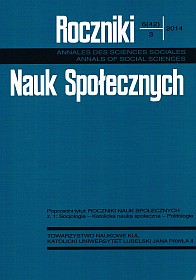Państwa Partnerstwa Wschodniego w polityce migracyjnej Polski i UE – dylematy i uwarunkowania
Abstrakt
The main aim of the article is to analyze the dominant trends and determinants of migration processes from Eastern Partnership countries (EaP) to the European Union (EU) and Poland in the context of the state and EU migration policy. One of the important determinants is growing political and economic competition between the EU and Russia as main destinations for migrants from EaP countries. The article focuses on the key rules and instruments implemented within EU migration policy and its role in management of the human flows from the EaP countries as well as Poland’s position as a destination country for EaP citizens. The main hypotheses elaborated in the article are as follows: 1) migrants from EaP countries become (except the EU mobility) the most important source of desirable foreign workers, especially in Poland and CEE countries; 2) migration policy is an integral part of foreign policy and neighbourhood policy of the EU which is determined by the competition with Russia for political and economic influence in the region; 3) the last developments within Poland’s migration policy indicate the activities to attract migrants from EaP countries (Ukraine and Belarus in particular) to arrive and work in Poland.
Bibliografia
Arcipowska M.: Dialog wizowy Unii Europejskiej z krajami Partnerstwa Wschodniego, Biuletyn PISM, Nr 91(840), 2011, w: https://www.pism.pl/index/?id=d57edf2d2082b0865e15d11edaecdb20
Barbone L., Kahanec M., Kureková L., Zimmermann K.F.: Migration from the Eastern Partnership Countries to the European Union – Options for a Better Future, IZA Research Report No. 55/2013, http://www.iza.org/en/webcontent/publications/reports
Di Bartolomeo A., Makaryan S., Mananashvili S., Weinar A.: Circular Migration in Eastern Partnership Countries. An overview. CARIM-East Research Report 30/2012, http://www.carim-east.eu/publications/research-reports/
Duszczyk M., Góra M., Kaczmarczyk P.: Costs and Benefits of Labour Mobility between the EU and the Eastern Partnership Countries – case of Poland, IZA Paper No. 7664/2013, http://ftp.iza.org/dp7664.pdf
EU Neighbourhood Migration Report 2013, Migration Policy Centre, European University Institute, http://www.migrationpolicycentre.eu/migration-report/
Recent Trends in International Migration in Poland. The 2011 SOPEMI report, red. Fihel A., CMR Working Papers 52(110), 2011, Warszawa: Ośrodek Badań nad Migracjami UW, http://www.migracje.uw.edu.pl/publ/1778/
Eastern Borders Annual Risk Analysis, Frontex 2013, http://frontex.europa.eu/publications/?c=risk-analysis
Lesińska M.: Polityka migracyjna Polski a procesy napływowe z Ukrainy, w: Brunarska Z., Grotte M., Lesińska M.: Migracje obywateli Ukrainy do Polski w kontekście rozwoju społeczno-gospodarczego: stan obecny, polityka, transfery pieniężne, CMR Working Paper 60(118), 2012, Warszawa: Ośrodek Badań nad Migracjami UW, http://www.migracje.uw.edu.pl/publ/2017/
Polityka migracyjna Polski – stan obecny i postulowane działania. Warszawa: Ministerstwo Spraw Wewnętrznych 2012.
Weinar A., Korneev O., Makaryan S., Mananashvili S.: Consequences of Schengen Visa Liberalisation for the Citizens of Ukraine and the Republic of Moldova, Migration Policy Centre Research Report 01/2012, http://cadmus.eui.eu/handle/1814/23497
Word Bank, Migration and Remittances Factbook 2011, Washington, DC: World Bank 2011.
Copyright (c) 2014 Roczniki Nauk Społecznych

Utwór dostępny jest na licencji Creative Commons Uznanie autorstwa – Użycie niekomercyjne – Bez utworów zależnych 4.0 Międzynarodowe.


